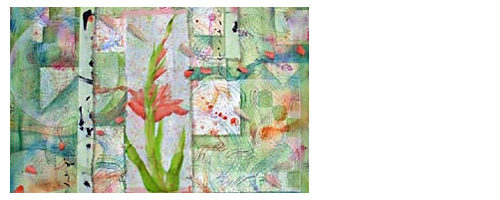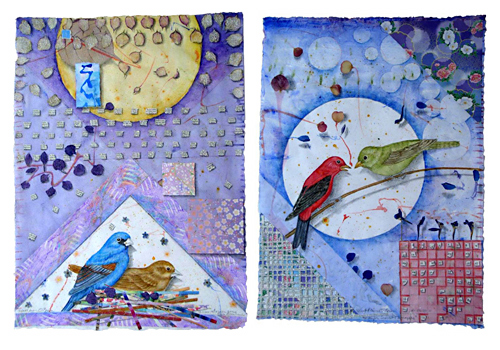“Beauty should be shared, for it enhances our joys.
To explore its mystery is to venture towards the sublime.”
―Joseph Cornell

I hesitate to use a sports term to begin this review, but, since the Summer Olympics opened last night, I’ll set my disinclination aside to state emphatically that artist Kathleen O’Brien is at the top of her game!
Gardenshapes —an exhibition of her mixed-media collage finishing its run in the main gallery of Danville’s Community Arts Center— has ample proof to support my claim. I made one more return visit yesterday to experience the diverse subtleties of her singular creations.
Inspired by birds and flowers, and exploring the garden as a metaphor, this collection of artworks represents everything that has captivated me for years about Kathleen’s approach. These works have clearly grown out of how she thoughtfully observes and attunes with nature. They also literally contain and preserve natural ingredients. But in contrast to collage that maintains its focus on formal or intellectual juxtapositions, Kathleen’s art always nudges one toward a deeper sense of wholeness and the inner complexity of our balanced existence as both organic and spiritual beings. Without question, she has made a personal commitment to creating art as a mystical practice, and, on a communal level, to providing nature-inspired beauty as a source of healing in a fractured world.
With the strong presence of these intangible dimensions, Kathleen’s art is always esoteric, and yet she manages to make the work accessible to all with her choice of subject matter and allegiance to traditional drawing. At the same time, she can delight the eye of a fellow artist with her methodology, aesthetic choices, and pictorial skill. I’m not ashamed to admit that much of Kathleen’s symbolic virtuosity is beyond my ken, but I appreciate that it’s all in play at the intuitive level. Being near the prolific output of her creative life is simply uplifting, and that’s because all the facets of her art —whether conscious or subliminal— unify as a total perception to nourish the mind, heart, and soul.
Getting back to the show, I was initially struck by the five largest pieces (28 x 36 inches), beautifully presented against white in deep gallery-style frames of natural wood. This “look” is familiar to those who know Kathleen’s art, and enhances the work’s identity as an unique artifact, preserved behind glass, like a rare botanical or zoological specimen. They are titled with reference to the garden theme. In contrast, a separate piece (24 x 30 inches) is presented with its surface exposed in the manner of an easel painting. It looks equally at home, released from behind the glass, expertly varnished in a way that does not distract. Its name is Heaven & Earth, Yin & Yang, Dark & Light, Birds & Trees, Flowers & Bees. My eyebrows lifted as I began to read the lengthy title, but was pleased with the closing rhyme as I finished. This artist always has a quiet surprise in store. Each of the large works is visually distinctive, but very much a cohesive part of a series unified by her long dedication to compositional abstraction, to a consistent theory of color, and to diligent mark making.
The large piece titled Garden for Queen Anne’s Lace is marked by a cellular pattern resembling microscopic tissue, which, while remaining highly abstract, transforms itself into a flower garden, with an interesting emphasis on each “drop of Queen’s blood” that, when closely examined, becomes a dance of circles, squares, and triangles —a dynamic that exemplifies Kathleen’s knack for taking the observer/participant through layers of meaning. The design also incorporates the application of illustrated postage stamps. Kathleen is never far removed from a devotion to cultural references and ephemera, and her Joseph Cornell influences are ever present. A fine example of this are four pieces dedicated to bird-species (16 x 20 inches) that combine found printed patterns with her typical labor of liquid media. Nests are created with random shards and colorful scraps. Dried and painted star-like blossoms effectively merge the organic, symbolic, and celestial. In Kathleen’s collage there are many allusions to language, both literal and archetypal, and here we discover many fragments of the printed word, as well as her “trademark” calligraphy. I was particularly drawn to Garden for Blue Grosbeaks, a strong arrangement of symmetrical and asymmetrical elements that carries out more of her evident investigation into fundamental shapes —circle, square, and triangle. These compositions are anything but static, a characteristic of Kathleen’s art built on a myriad of ways in which she provokes eye movement by simulating the dynamic patterns of nature, often with the application of actual plants and minerals. A perfect case in point is 9 Bird Eggs (30 x 30 inches), with its nimble use of botanicals most artists would overlook as raw material, through which she creates a variety of rhythms within a formal, 3×3 grid structure.
I should mention that Kathleen’s control of what I call “implied viewing distance” is masterful. Enjoying her watercolor effects and hidden treasures up close is inevitably a satisfying experience, as is true with much of current small-scale mixed media collage, but her pieces also can be savored at a distance. I found myself continually studying a work from across the room and then, taking off my eye-wear, sticking my nose near the glass to examine fine detail. Whether from this point of view or from half a block away, Kathleen’s distinctive impression is always recognizable, an enviable accomplishment for any artist. For example, both Royal Lily Garden and Staple Garden contain brushwork that only can be achieved by someone who is continuously handling liquid on a tool and is fully at ease with her surface. On the other hand, she uses this micro-fluency to create the intended multi-layered depth of her macro-composition, and yet I was constantly invited to step back into the intimacy of the picture plane, much as one feels when standing back to admire a flower garden, while being compelled to converge at hand’s length, only to spy a miniature surprise —a dutiful pollinator or tiny feat of nature’s diversity within repetition.
With my fixation on the bigger paintings, it was too easy to neglect the smaller items, so I had to instruct myself to visually isolate and appreciate several other works. Two of these were within squares, and each have treatments not as pronounced elsewhere in the exhibition. Feathers uses paper itself as a dimensional medium, and The Blessing of Rain features a darker atmospheric background —a shimmering chalk texture that makes me wish Kathleen would more intensively explore the potential of pastel effects. In addition, there are three bird portraits (9 x 12 inches), with coatings of what appeared to be beeswax, which recall for me the investigations of 19th-century naturalists. My favorite is Garden for Eastern Bluebirds, with its deft pencil work and luscious color palette. Kathleen pushes her highly capable layering beyond technique to create a sense of time distortion, an interplay of wildlife and cultural antiquity that makes certain the work is much more than a lovely rendering of birds. Throughout this outstanding show are many such allusions to natural and human-made cycles that fuse the worlds of growing things and a striving race that has always responded with symbolic culture to seek a balanced place in the scheme of life.
Indeed, Kathleen O’Brien has found her place. With a home studio close to nature, and a creative passion that distills her observations and meditations through heart, head, and hand, she is a gold-medal artist of the soul.
© 2012, John Andrew Dixon
Garden for Eastern Bluebirds and Garden for Scarlet Tanagers
by Kathleen O’Brien
